Image of a Map Were Grizzly Bears Live Image of Baby Liones
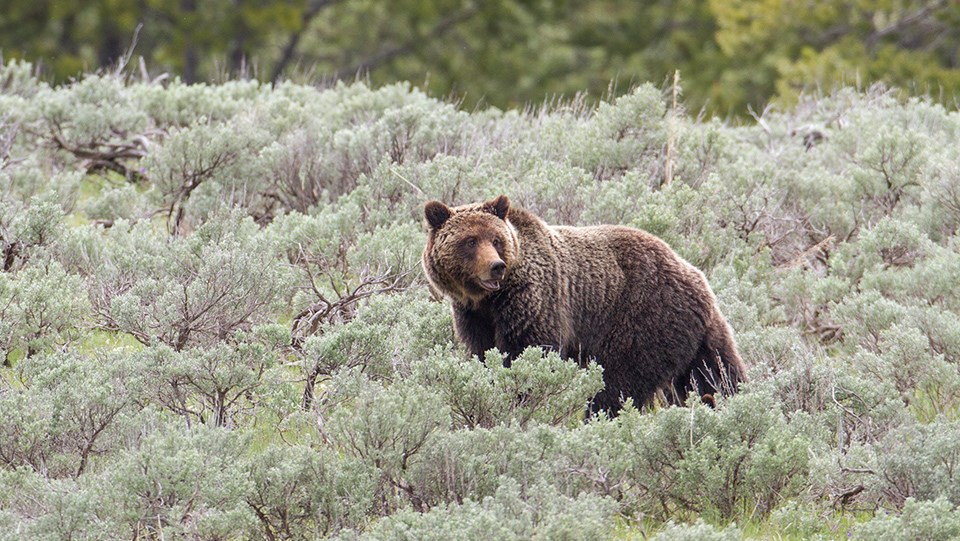
NPS / Jim Peaco
Yellowstone is home to two species of bears: grizzly bears and black bears. Of the two species, grizzly bears have a much smaller range across the United States. The grizzly comport is typically larger than the black bear and has a big muscle mass above its shoulders; a concave, rather than straight or convex, facial profile; and much more than aggressive behavior. The grizzly deport is a subspecies of brown bear that one time roamed large swaths of the mountains and prairies of the American West. Today, the grizzly carry remains in a few isolated locations in the lower 48 states, including Yellowstone.In littoral Alaska and Eurasia, the grizzly behave is known as the chocolate-brown bear.
Visitors should be aware that all bears are potentially dangerous. Park regulations require that people stay at least 100 yards (91 chiliad) from bears (unless safely in your car as a behave moves by). Bears need your business organisation, not your food; it is confronting the law to feed any park wildlife, including bears.
The Greater Yellowstone Ecosystem and northwest Montana are the but areas south of Canada that all the same have large grizzly bear (Ursus arctos horribilis) populations. Grizzly bears were federally listed in the lower 48 states every bit a threatened species in 1975 due to unsustainable levels of human-caused mortality, habitat loss, and significant habitat alteration. Grizzly bears may range over hundreds of foursquare miles, and the potential for conflicts with human being activities, peculiarly when human food is nowadays, makes the presence of a viable grizzly population a continuing claiming for its human being neighbors in the Greater Yellowstone Ecosystem.
Population
The estimated Greater Yellowstone Ecosystem grizzly carry population increased from 136 in 1975 to a top of 757 (estimated) in 2014. The 2019 population estimate is 728 bears. The bears accept gradually expanded their occupied habitat by more than than l%. As monitored by the Interagency Grizzly Bear Study Team, the criteria used to determine whether the population within the Greater Yellowstone Ecosystem has recovered include estimated population size, distribution of females with cubs, and mortality rates. An estimated 150 grizzly bears occupy ranges that lie partly or entirely within Yellowstone. The number of females producing cubs in the park has remained relatively stable since 1996, suggesting that the park may exist at or near ecological carrying capacity for grizzly bears.
One visitor was inured by a grizzly bear in 2021.
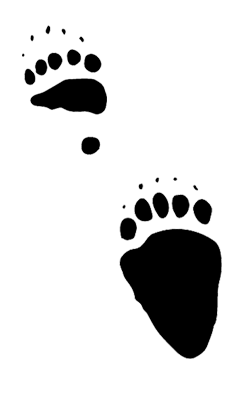
NPS
Description
The grizzly acquit's color varies from blond to black, ofttimes with pale-tipped guard hairs. In the Greater Yellowstone Ecosystem, many grizzly bears accept a light-brown girth ring. However, the coloration of blackness and grizzly bears is so variable that it is non a reliable means of distinguishing the two species.
Bears are by and large solitary, although they may tolerate other bears when food is plentiful. Grizzlies have a social hierarchy in which adult male bears dominate the all-time habitats and food sources, generally followed by mature females with cubs, and so past other unmarried adult bears. Subadult bears, who are just learning to live on their ain abroad from mother'southward protection, are most likely to be living in poor-quality habitat or in areas nearer roads and developments. Thus, immature adult bears are most vulnerable to danger from humans and other bears, and to existence conditioned to homo foods. Food-conditioned bears are removed from the wild population.
Nutrition
Bears are generalist omnivores that tin can only poorly digest parts of plants. They typically provender for plants when they have the highest food availability and digestibility. Although grizzly bears make substantial use of forested areas, they make more apply of large, nonforested meadows and valleys than black bears. The longer, less curved claws and larger shoulder musculus mass of the grizzly bear makes it better suited to dig plants from the soil, and rodents from their caches.
Grizzly bear food consumption is influenced by almanac and seasonal variations in available foods. Over the course of a year, ground forces cutworm moths, whitebark pine nuts, ungulates, and cutthroat trout are the highest-quality food items bachelor. In total, grizzly bears in the Greater Yellowstone Ecosystem are known to consume at least 266 species of plant (67%), invertebrate (15%), mammal (11%), fish, and fungi. They volition eat human food and garbage where they tin can get it. This is why managers emphasize that keeping human foods secure from bears increases the likelihood that humans and bears can peacefully coexist in greater Yellowstone.
Bears spend about of their time feeding, specially during "hyperphagia," the catamenia in fall when they may proceeds more 3 pounds per day until they enter their dens to hibernate. In years and locations when whitebark pine nuts are available, they are the most of import behave food from September through October. However, not all bears have access to whitebark pino nuts, and in the absence of this loftier-quality nutrient, the bear'due south omnivory lets them turn to dissimilar food sources. Fall foods also include pondweed root, sweet cicely root, grasses and sedges, bistort, yampa, strawberry, globe huckleberry, grouse whortleberry, buffaloberry, clover, horsetail, dandelion, ungulates (including carcasses), ants, fake truffles, and regular army cutworm moths.
From late March to early May, when they come out of hibernation, until mid May, a grizzly comport'due south diet primarily consists of elk, bison, and other ungulates. These ungulates are primarily winter-killed feces (already dead and decaying animals), and elk calves killed by predation. Grizzly bears dig upwardly caches fabricated by pocket gophers. Other items consumed during leap include grasses and sedges, dandelion, clover, spring-beauty, horsetail, and ants. When there is an abundance of whitebark seeds left from the previous fall, grizzly bears will feed on seeds that red squirrels have stored in middens.
From June through August, grizzly bears eat thistle, biscuitroot, fireweed, and regular army cutworm moths in addition to grasses and sedges, dandelion, clover, jump-beauty, whitebark pine nuts, horsetail, and ants. Grizzly bears are rarely able to catch elk calves later on mid-July. Starting around mid-summer, grizzly bears begin feeding on strawberry, globe huckleberry, bickering whortleberry, and buffaloberry. By late summer, simulated truffles, bistort, and yampa are included in the diet as grasses and others become less prominent.
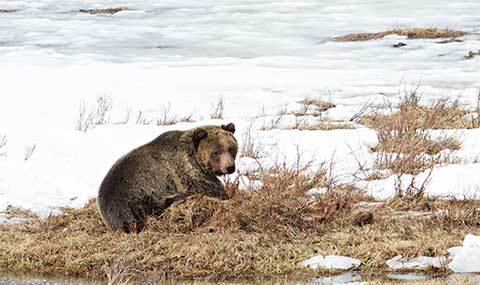
NPS / Jim Peaco
Hibernation
Bears' annual denning behavior probably evolved in response to seasonal food shortages and cold conditions. Bears hibernate during the winter months in near of the world. The length of denning depends on latitude, and varies from a few days or weeks in Mexico to six months or more in Alaska. Pregnant females tend to den before and longer than other bears. Grizzly bear females without cubs in Greater Yellowstone den on average for about v months.
Grizzly bears will occasionally re-use a den in greater Yellowstone, especially those located in natural cavities like stone shelters. Dens created by earthworks, as opposed to natural cavities, unremarkably cannot exist reused because runoff causes them to collapse in the bound. Greater Yellowstone dens are typically dug in sandy soils and located on the mid to upper onethird of mildly steep slopes (30–lx°) at 6,562–10,000 anxiety (2,000–3,048 one thousand) in elevation. Grizzly bears frequently excavate dens at the base of operations of a large tree on densely vegetated, north-facing slopes. This is desirable in greater Yellowstone because prevailing southwest winds accumulate snowfall on the northerly slopes and insulate dens from sub-cypher temperatures.
The excavation of a den is typically completed in iii–7 days, during which a bear may movement upwards to one ton of cloth. The den includes an entrance, a brusque tunnel, and a chamber. To minimize heat loss, the den entrance and sleeping room is usually just large enough for the bear to clasp through and settle; a smaller opening volition be covered with snow more speedily than a large opening. Afterwards excavation is complete, the acquit covers the chamber floor with bedding fabric such every bit spruce boughs or duff, depending on what is available at the den site. The bedding material has many air pockets that trap body estrus.
The trunk temperature of a hibernating acquit, remains inside 12°F (22°C) of their normal torso temperature. This enables bears to react more quickly to danger than hibernators who accept to warm up start. Considering of their well-insulated pelts and their lower surface area-to-mass ratio compared to smaller hibernators, bears lose body oestrus more than slowly, which enables them to cut their metabolic rate by 50–60%. Respiration in bears, normally 6–ten breaths per minute, decreases to i jiff every 45 seconds during hibernation, and their centre rate drops from 40–fifty beats per minute during the summer to 8–xix beats per minute during hibernation.
Bears sometimes awaken and leave their dens during the winter, but they mostly do not eat, potable, defecate, or urinate during hibernation. They live off of a layer of fat congenital upwardly prior to hibernation. The urea produced from fatty metabolism (which is fatal at high levels) is broken down, and the resulting nitrogen is used by the carry to build protein that allows information technology to maintain muscle mass and organ tissues. Bears may lose xv–30% of their body weight but increase lean body mass during hibernation.
Bears emerge from their dens when temperatures warm up and nutrient is available in the grade of winterkilled ungulates or early spring vegetation. Greater Yellowstone grizzly bears begin to emerge from their den in early February, and most bears take left their dens past early May. Males are likely to emerge before females. Most bears usually leave the vicinity of their dens within a week of emergence, while females with cubs typically remain within ane.86 miles (3 km) of their dens until late May.
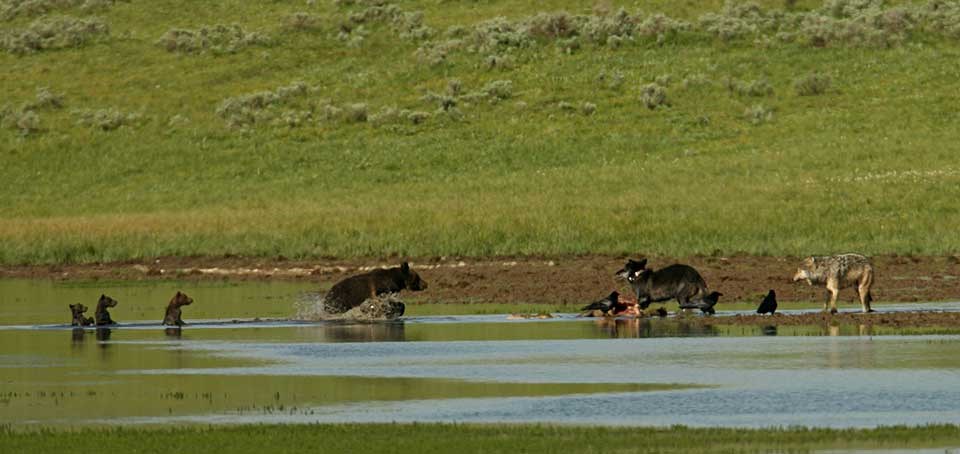
NPS / Jim Peaco
Grizzly Bears, Black Bears, and Wolves
Grizzly bears are more than ambitious than black bears, and more likely to rely on their size and aggressiveness to protect themselves and their cubs from predators and other perceived threats. Their evolution diverged from a mutual ancestor more 3.five million years agone, simply their habitats but began to overlap near xiii,000 years ago. Grizzly bears, black bears, and gray wolves have historically coexisted throughout a large portion of North America. The behavior of bears and wolves during interactions with each other are dependent upon many variables such as age, sex, reproductive status, prey availability, hunger, aggressiveness, numbers of animals, and previous experience in interacting with the other species. Most interactions between the species involve food, and they commonly avoid each other. Few instances of bears and wolves killing each other have been documented. Wolves sometimes kill bears, only unremarkably only cubs.
Wolves prey on ungulates yr-round. Bears feed on ungulates primarily every bit wintertime-killed carcasses, ungulate calves in spring, wolf-killed carcasses in spring through fall, and weakened or injured male person ungulates during the fall rut. Bears may benefit from the presence of wolves by taking carcasses that wolves have killed, making carcasses more available to bears throughout the year. If a bear wants a wolf-killed brute, the wolves will try to defend it; wolves usually neglect to chase the carry away, although female grizzlies with cubs are seldom successful in taking a wolf-kill.

Bear Safety
All-time practices for traveling safely in comport country.
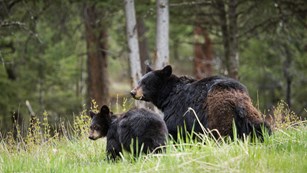
Black Bear
Black bears are commonly seen in Yellowstone.

Bear Management
Bear management has evolved since the park was established.
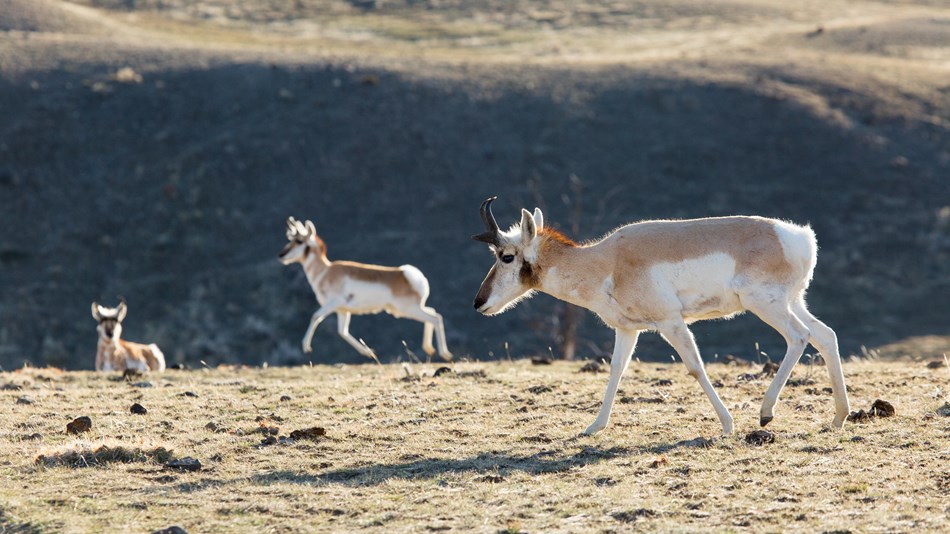
Mammals
All of the park's hoofed mammals drift across the park to find the best plant growth.
Grizzly Bear Related Information
Resources
2015. Yellowstone Science 23:2. Yellowstone Center for Resource, Mammoth WY.
2007. Final Conservation Strategy for the Grizzly Comport in the Yellowstone Expanse. Interagency Grizzly Bear Study Team.
2009. Greater Yellowstone Coalition, Inc. 5. Servheen et al. Vol. CV 07-134-M-DWM. Us Commune Court for the District of Montana, Missoula Sectionalisation.
Bjornlie, D. D., F. T. van Manen, K. R. Ebinger, M. A. Haroldson, D. J. Thompson, C. One thousand. Costello. 2014. Whitebark pine, population density, and homerange size of grizzly bears in the Greater Yellowstone Ecosystem. PloS Ane doi x.1371/journal. pone.0088160.
Coleman, T.H., C.C. Schwartz, K.A. Gunther, and S. Creel. 2013. Grizzly carry and man interaction in Yellowstone National Park: an evaluation of Comport Management Areas. Periodical of Wildlife Management 77(seven):1311-1320.
Costello, C. M., F. T. van Manen, M. A. Haroldson, M. R. Ebinger, Due south. Cain, K. Gunther, and D. D. Bjornlie. 2014. Influence of whitebark pine decline on fall habitat use and movements of grizzly bears in the Greater Yellowstone Ecosystem. Ecology and Evolution. 4(10):2004-2018.
Craighead, J.C., J.South. Sumner, and J.A. Mitchell. 1995. The grizzly bears of Yellowstone: Their ecology in the Yellowstone ecosystem. Washington, DC: Isle Printing.
Fortin, J.K., C.C. Schwartz, K.A. Gunther, J.E. Teisberg, K.A. Haroldson, M.A. Evans, and C.T. Robbins. 2013. Dietary adjustability of grizzly bears and American Black Bears in Yellowstone National Park. Journal of Wildlife Direction 77(2): 270–281.
Gunther, K.A. and T. Wyman. 2008. Homo habituated bears: The next challenge in carry direction in Yellowstone National Park. Yellowstone Science 16(2): 35–41.
Gunther, One thousand., R. Shoemaker, K. Frey, 1000. A. Haroldson, South. L. Cain, F. T. van Manen, and J. M. Fortin. 2014. Dietary breadth of grizzly bears in the Greater Yellowstone Ecosystem. Ursus. 25(one):threescore–72.
Haroldson, M.A., and Yard.A. Gunther. 2013. Roadside comport viewing opportunities in Yellowstone National Park: characteristics, trends, and influence of whitebark pino. Ursus 24(1):27–41.
Haroldson, Thousand.A., C.C. Schwartz, Chiliad.C. Kendall, K.A. Gunther, D. Southward. Moody, K. Frey, and D. Paetkau. 2010. Genetic analysis of individual origins supports isolation of grizzly bears in the Greater Yellowstone Ecosystem. Ursus 1:1–13.
Herrero, S. 1985. Acquit attacks: Their causes and abstention. New York: Nick Lyons Books.
Interagency Grizzly Bear Study Team. 2013. Response of Yellowstone grizzly bears to changes in food resources: A synthesis. Study to the Interagency Grizzly Bear Committee and Yellowstone Ecosystem Subcommittee. U.S. Geological Survey, Northern Rocky Mountain Science Middle, Bozeman, Montana, U.s.. https://www.usgs.gov/science/interagency-grizzly-conduct-study-team?qt-science_center_objects=iv#qt-science_center_objects
Meagher, M. 2008. Bears in transition, 1959–1970s. Yellowstone Science 16(2): 5–12.
Middleton, A.D., T.A. Morrison, J.K. Fortin, M.J. Kauffman, C.T. Robbins, K.K. Proffitt, P.J. White, D.E. McWhirter, T.Yard. Koel, D. Brimeyer, and W.South. Fairbanks. 2013. Grizzly bears link not-native trout to migratory elk in Yellowstone. Proceedings of the Regal Society B 280:20130870.
Richardson, Leslie, Tatjana Rosen, Kerry Gunther, and Chuck Schwartz. 2014. The economics of roadside bear viewing. Journal of Environmental Management. 140:102-110.
Schullery, P. 1992. The bears of Yellowstone. Worland, Wyoming: Loftier Plains Publishing Company.
Schwartz, C.C., Thousand.A. Haroldson, Yard.C. White, R.B. Harris, South. Cherry, Grand.A. Keating, D. Moody, and C. Servheen. 2006. Temporal, spatial, and environmental influences on the demographics of grizzly bears in the Greater Yellowstone Ecosystem. Wild fauna Monographs 161(1):i–68.
Schwartz, C.C., K.A. Haroldson, and 1000.C. White. 2010. Hazards affecting grizzly carry survival in the greater Yellowstone ecosystem. Periodical of Wildlife Management 74(4):654–667.
Schwartz, C.C., M.A. Haroldson, Yard. West, and et al. Yellowstone grizzly carry investigations: Annual reports of the Interagency Grizzly Carry Study Squad, Edited past US Section of the Interior. Bozeman, MT.
Teisberg, J. Due east., Haroldson, K. A., Schwartz, C. C., Gunther, K. A., Fortin, J. K. and Robbins, C. T. 2014. Contrasting past and electric current numbers of bears visiting Yellowstone cutthroat trout streams. Journal of Wildlife Management, 78: 369–378.
White, P.J., R.A. Garrott, and Thousand.E. Plumb, eds. 2013. Yellowstone'due south Wildlife in Transition. Cambridge, Massachusetts: Harvard University Press.
van Manen, F. T., Ebinger, Thousand. R., Haroldson, M. A., Harris, R. B., Higgs, M. D., Cherry, Due south., White, Chiliad. C. and Schwartz, C. C. (2014), Re-Evaluation of Yellowstone Grizzly Bear Population Dynamics not Supported by Empirical Data: Response to Doak & Cutler. Conservation Messages, 7: 323–331.
tomlinsoncooll1996.blogspot.com
Source: https://www.nps.gov/yell/learn/nature/grizzlybear.htm
0 Response to "Image of a Map Were Grizzly Bears Live Image of Baby Liones"
Postar um comentário